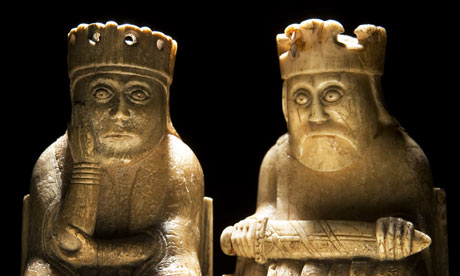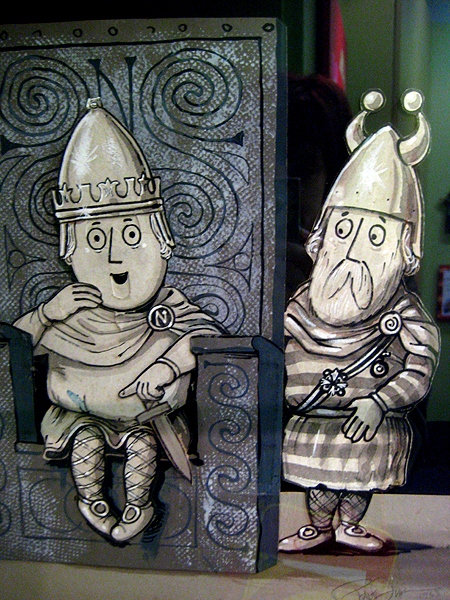I like their expressive faces – the bulging eyes and Dwayne Dibley teeth. They are very intricate, even down to the strands of hair and ornamental carvings in the chairs on which they sat. They seem to follow slightly different patterns which could possibly be due to different craftsmen making them from the same workshop, and some are clearly replacement pieces made later on – there are about 70 pieces all together.
The history of the pieces is shrouded in tales of murder, deception, folklore and legend. A local man, Malcolm MacLeod, said his cattle were grazing on Uig Bay sand dunes (which suggests they must be grassy sand dunes) when he discovered the chessmen. The minister of Lewis preached against idols (the island was strictly Protestant) so Malcolm was afraid of what he had found and took them to the minister in great trepidation. The story before that (or how they came to be in the sand dunes) is that a young boy washed up on shore with them in a bag (the exhibition includes a carved buckle which may have come from this bag) and met a man who promised he would lead him to safety, but instead hit him on the head with a rock and stole them.
Archeological problems are posed by these pieces because nothing else like them has been discovered. Walrus ivory is a popular material for work in Trondheim and Dublin, which makes sense because they were part of the Viking trading route: Greenland; Iceland; Trondheim; Shetland/ Orkney/ Lewis Islands; Isle of Man; Dublin. In the 790s the Vikings raided the Western Isles with a series of brutal attacks on coastal communities and monasteries. Tradition says there was a monastery at Mealasta but there is no evidence of this. Lewis was a Scandinavian island and didn’t revert to Scottish rule until 1266.
The characters are in the likeness of warders, kings, queens, pawns, knights and bishops. They were probably used at chess, tables (a predecessor of backgammon), and a game called hnefatafl. There is nothing like this from similar times in the otherwise progressive Islamic artistic tradition where craftsmen were reluctant to portray humans for religious reasons.
The kings each hold a sword in two hands as though in the act of drawing it – classic mythology says kings did this while listening to the words of Odin. The queens, resting their cheek on their hand, all look vaguely fed up. The bishops were a new feature on chessboards when these were made – this may reflect the importance and patronage of archbishops based in Trondheim (Trondheim was the seat of archbishops).
In true Wikipedia fashion, the exhibition provides information as to how and where these figures have been used in popular culture: they are the inspiration for J.K. Rowling’s wizard chess; the template for Rosemary Sutcliffe’s Chess-Dream in a Garden; and the motivation for Oliver Postgate’s Noggin the Nog. He writes that he noticed, “far from being warlike, it was clear that these were essentially kindly, non-belligerent characters, who were thoroughly dismayed by the prospect of contest.”




No comments:
Post a Comment